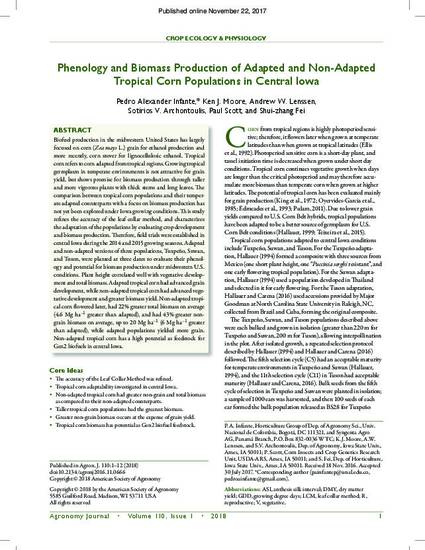
Biofuel production in the midwestern United States has largely focused on corn (Zea mays L.) grain for ethanol production and more recently, corn stover for lignocellulosic ethanol. Tropical corn refers to corn adapted from tropical regions. Growing tropical germplasm in temperate environments is not attractive for grain yield, but shows promise for biomass production through taller and more vigorous plants with thick stems and long leaves. The comparison between tropical corn populations and their temperate adapted counterparts with a focus on biomass production has not yet been explored under Iowa growing conditions. This study refines the accuracy of the leaf collar method, and characterizes the adaptation of the populations by evaluating crop development and biomass production. Therefore, field trials were established in central Iowa during the 2014 and 2015 growing seasons. Adapted and non-adapted versions of three populations, Tuxpeño, Suwan, and Tuson, were planted at three dates to evaluate their phenology and potential for biomass production under midwestern U.S. conditions. Plant height correlated well with vegetative development and total biomass. Adapted tropical corn had advanced grain development, while non-adapted tropical corn had advanced vegetative development and greater biomass yield. Non-adapted tropical corn flowered later, had 22% greater total biomass on average (4.6 Mg ha–1 greater than adapted), and had 43% greater non-grain biomass on average, up to 20 Mg ha–1 (6 Mg ha–1 greater than adapted), while adapted populations yielded more grain. Non-adapted tropical corn has a high potential as feedstock for Gen2 biofuels in central Iowa.
Available at: http://works.bepress.com/andrew_lenssen/125/

This article is published as Infante, Pedro Alexander, Ken J. Moore, Andrew W. Lenssen, Sotirios V. Archontoulis, Paul Scott, and Shui-zhang Fei. "Phenology and Biomass Production of Adapted and Non-Adapted Tropical Corn Populations in Central Iowa." Agronomy Journal (2017). doi: 10.2134/agronj2016.11.0666.